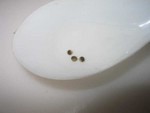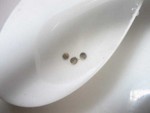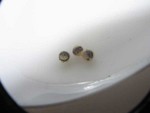Re: Close-up photography & macro lens

Originally Posted by
keehoe
I got myself a second hand macro lens but doesn't know how to use it. Looks like i need a telescopic macro lens with magnifying capability
Kee Hoe,
I'm using a simple P&S Canon PowerShot A85 and at macro mode, the minimum focussing distance is 5cm. While ok for taking picture of a whole fish, it's not good enough for smaller items like fry and eggs.
To achieve closer distance, larger image or higher magnification, specialized equipment like dedicated macro lens or macro bellow set (for 1:1 magnification ratio and higher) is used in conjunction with built-in ring flash or multiple off hot-shoe flashes.
In lieu of all those equipment, but at a compromise in quality, you can experiment with various magnifying objectives, held close to the camera's lense. Below are a few full-frame images of sturisoma eggs.
From Left to Right; at macro mode (5cm minimum), with hand held magnifier (those glass type with handle and metal/plastic frame) and with a loupe (10x, I think). The strip of grey is a shadow from the magnifier len's frame. (re-compose the image after focussing, so that lighted area is more even)



After cropping & resize of the last image, while details are not at it's best, is acceptable for general observation.

If egg development is not your area of interest, the best way I know to shoot fishes is in a smaller photo tank. Set your camera to macro with flash and angle the camera slightly downwards, to avoid direct reflection from the flash.
I'm back & keeping 'em fingers wet,
Ronnie Lee









 Reply With Quote
Reply With Quote
















Bookmarks